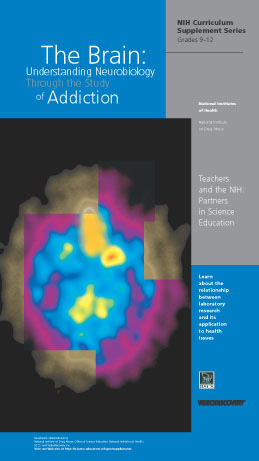
In collaboration with the National Institutes of Health (NIH) Office of Science Education (OSE), NIDA has developed a new, free educational resource for adolescents. The science curriculum supplement is designed to bring current scientific knowledge about drug abuse and addiction into high school classrooms across America. The new resource is part of NIDA's continuing effort to improve science education and literacy and to counter prevailing myths about drug abuse with science-based information.
The supplement provides information on drug abuse and addiction that can be added to an existing high school science curriculum. "These materials work in science classrooms because they incorporate concepts included on State standardized tests and are aligned with National Science Education Standards - guidelines released by the National Research Council that outline student knowledge and skills necessary for science literacy at different grade levels," says Dr. Cathrine Sasek, science education coordinator in NIDA's Office of Science Policy and Communications.
Current Information for a New Audience
Most of NIDA's science education resources have been written for middle school students. The new curriculum supplement offers a more sophisticated presentation of scientific information about drug abuse and addiction, appropriate for high school students. The supplement covers how the brain works, how drugs affect the brain, and how specific drugs alter neurochemicals and interact with the brain's reward system.
"The materials are self-contained and flexible, so teachers can adjust lessons to their students' level of knowledge," says Dr. Sasek. "For students, the supplement provides an opportunity to acquire accurate scientific information about drug addiction so they may reject common myths about drugs."
Like all NIH OSE curriculum supplements, the NIDA resource provides current scientific data and inquiry-based activities that may be used in sequence or individually. The supplement contains two parts - a teacher's manual that presents a set of engaging activities and an interactive CD-ROM that shows vivid brain images and video sequences that bring neuroanatomy, neurophysiology, and neurochemistry to life for students. The manual includes extensive background materials, a glossary, a list of additional resources, and handouts that can be duplicated.
The curriculum's developers incorporated evaluations from teachers and scientists who are experts on drug addiction into the supplement to ensure that the resource is accurate, practical for teachers, and interesting to students. Evaluators conducted field tests and focus groups with teachers to identify tools that would be most effective for high school science classrooms. "The use of teacher and other expert feedback to constantly improve the supplement resulted in very usable science-based materials," says Dr. Sasek.
Broad Dissemination Planned
OSE plans to release the materials next summer and expects ultimately to print about 20,000 curriculum supplements. Efforts now are focused on encouraging use of the supplement in classrooms across the Nation. "It is a difficult task to get the word out to all the science teachers in the country, but it is key to the success of the supplement," says NIDA Associate Director Dr. Timothy P. Condon. OSE and NIDA are working closely with the National Association of Biology Teachers (NABT) to increase awareness of the supplement. NABT's regional and national meetings will offer workshops so that teachers can explore the materials and sign up to receive them. After teachers have had a chance to use the supplement, they will be asked for feedback to determine the impact of the materials on student knowledge.
The new supplement is just one piece of NIDA's broad and interconnected science education program, Dr. Sasek explains. For example, NIDA plans to release learning materials designed for second and third grades in 2001, followed by materials appropriate for kindergarten and first grade. "The overall goal is general science literacy regarding drug abuse and addiction - for any person on the street to know how drugs influence the brain. It is critical to start science-based education early on drug abuse and addiction," says Dr. Sasek. "Our goal is to cover kindergarten through 12th grade so that students are constantly learning about this topic as they go through school. School-based efforts are part of our overall education of the general public."
NIDA's catalog of current science education materials and ordering information can be obtained through the Publications link on the NIDA web site. Educators may also order the resource on the NABT or NIH Web site (www.nabt.org or www.nih.gov).
